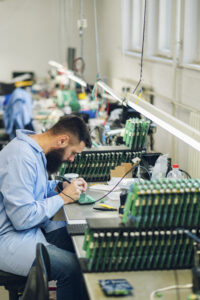In doing some research recently I came across a surprising technology and engineering breakthrough that’s been right under my nose for several years now. Even as someone who has worked in tech for decades, I was unfamiliar and surprised by this, but the more I thought about it, it started to really make sense.
What am I talking about? Although Solid State Drives (SSD) seem to grab all of the attention these days, traditional spinning hard disk drives (HDD) are not ready to fade into the sunset just yet. By using an element that is the second-most abundant in the universe, the industry has been able to “breathe new life into HDDs”, all thanks to Helium (He).
Western Digital was the first HDD manufacturer to successfully do this in 2012, with HDDs targeted at data centers and other large-scale deployments for “cold” data storage. Now other manufacturers are now commercially offering disk drive units that are filled with Helium (He) and then hermetically sealed to trap the gas in.
But why put He in HDDs?
First of all, compared to air, Helium has extremely low density. This contributes to less turbulence between the moving parts like the drive head and disk platters, which in turn “saves power consumption, produces less heat, produces fewer vibrations, makes less noise, allows greater drive capacity, and results in a much lower total cost of operation. The drives are expensive to manufacture, but that cost is recovered in energy savings and performance gains.” (Source: https://geology.com/stories/13/new-uses-of-helium/)
Based on this, it’s apparent that filling HDDs with helium has a number of benefits. To elaborate, we went straight to the innovator on this point, where the Western Digital blog page offered the following information, titled “The Helium Advantage”:
- Squeezing tracks closer together means more data tracks per disk = more data per HDD.
- Thinner disks = more disks (5 disks are now 8 disks) = more data per HDD.
- Thinner disks require less power to spin.
- Helium creates less drag, requiring less power to spin the disks.
- Less drag = less noise. (Helium drives are less annoying to listen to!)
- Sealed drives keep helium in and keep contaminants out.”
Impressive stuff, indeed! But it appears that the biggest challenge was keeping the helium sealed inside the drives, since molecules of this gas are smaller than air molecules. As Western Digital said, “Anyone who has purchased a helium filled balloon knows that after a few days, the helium leaks out.”
Eventually, Western Digital was able to perfect the sealing process for mass production, and now so have several other manufacturers, including key rivals Seagate and Toshiba. In fact, in late 2017 Toshiba announced a 12 TB He-filled HDD, once again raising the bar on capacity for this second wave of hard disk drive technology.
What do you think about Helium-filled HDDs? Have you tried this new technology in your data center deployment? If so, what sort of performance improvements have you noticed? Drop us a line and let us know – and as always, thanks for reading our Tech Blog!






